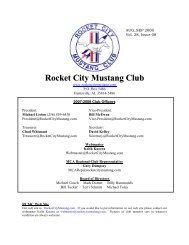2006 Ford Racing Performance Parts Catalog - Rocket City Mustang ...
2006 Ford Racing Performance Parts Catalog - Rocket City Mustang ...
2006 Ford Racing Performance Parts Catalog - Rocket City Mustang ...
Create successful ePaper yourself
Turn your PDF publications into a flip-book with our unique Google optimized e-Paper software.
4-CYLINDER ENGINES<br />
1.6L KENT/1.6L/1.9L CVH/2.0L/2.3L OHC/2.3L/2.5L HSC<br />
1.6L “KENT” ENGINE<br />
This is a proven overhead valve design.<br />
The combustion face of the head is virtually flat.<br />
Most of the combustion chamber is in a dished<br />
piston. Camshafts are mechanical with solid<br />
tappets. <strong>Parts</strong> for this engine are identified as<br />
1.6L Kent. You’ll find it under the hood of many<br />
<strong>Ford</strong> models, including Pinto, Capri, Fiesta and<br />
the English built Cortina. A “GT” performance<br />
version is the basis for an amateur class of<br />
racing…Formula <strong>Ford</strong>. Only production-type<br />
parts are normally legal in “formula” competition.<br />
Check with your racing association for the<br />
latest rules.<br />
1.6L “CVH” AND 1.9L “CVH”<br />
ENGINES<br />
The 1.6L CVH engine was introduced in 1981<br />
for the Escort, Lynx, EXP and LN7 car line.<br />
<strong>Parts</strong> for this engine are identified as 1.6L CVH.<br />
It has a canted valve head (CVH) with the valve<br />
angles to match the hemispherical combustion<br />
chambers. Reliefs are cut into its domed pistons<br />
to match valve and combustion chamber<br />
configuration. A hydraulic camshaft is used<br />
in production. A performance version was<br />
introduced in 1984 with electronic fuel injection<br />
and a turbocharger. A 1.9L CVH was introduced<br />
on 19851⁄2 models. It has a 4.250mm higher<br />
deck height to achieve a longer stroke.<br />
Some 1.6L/1.9L CVH parts are interchangeable.<br />
1.6L/1.9L CVH<br />
2.3L OHC (Turbo-Intercooled)<br />
1.6L/1.8L/2.0L DOHC ENGINE<br />
<strong>Ford</strong> currently offers four double overhead cam<br />
4-cylinder engines. The 1.6L DOHC was<br />
introduced on 1991 Capri, the 1.8L DOHC<br />
on 1991 Escort GT/Tracer LTS, a 2.0L DOHC<br />
on 1993 Probe, and a second 2.0L DOHC design<br />
on the 1995 Contour/Mystique. These engines<br />
feature four valves per cylinder and a centrally<br />
located spark plug in a “pentroof” combustion<br />
chamber for efficient air flow and combustion.<br />
<strong>Ford</strong> <strong>Racing</strong> parts have not been developed for<br />
these production double overhead cam engines.<br />
2.0L/2.3L/2.3L OHC ENGINES<br />
Design-wise, these metric engines are very<br />
similar and have a belt-driven overhead camshaft.<br />
Dimensionally, however, they are very different<br />
in terms of bore, stroke, bore spacing, block<br />
deck height and crankshaft journal diameters.<br />
The European (EAO) 2.0L was produced in<br />
1971-74 cars. The 2.3L OHC is widely found on<br />
1974-95 models…including a high-tech version<br />
that powered the Thunderbird/Cougar Turbo<br />
Coupe. A two spark plug per cylinder design with<br />
distributorless ignition was introduced on 1989<br />
Ranger and 1991 <strong>Mustang</strong> models. <strong>Parts</strong> for<br />
2.3L/2.5L HSC<br />
<strong>Ford</strong> <strong>Racing</strong> offers parts for five different 4-cylinder engines. Each is a unique design, and none of the major<br />
components can be interchanged between engines. Be sure to correctly identify your engine before ordering parts.<br />
these engines are identified as 2.0L EAO and<br />
2.3L OHC respectively. In 1983, a 2.0L version<br />
of the 2.3L OHC engine was introduced on<br />
Ranger and Aerostar trucks. The only basic<br />
difference is in bore diameter, as shown in the<br />
chart on page 217, thus most parts interchange.<br />
<strong>Parts</strong> shown for the 2.3L OHC can be used in the<br />
2.0L truck engine, except those relating to bore<br />
diameter (pistons, etc.). In 1998 the Ranger<br />
engine grows to 2.5L with increased stroke.<br />
2.2L PROBE ENGINE<br />
<strong>Ford</strong> introduced a new fuel injected 2.2L engine<br />
(in naturally aspirated and turbo versions) for<br />
1989 Probe models. It’s an overhead camshaft<br />
design with shaft-mounted rocker arms and<br />
three valves per cylinder (2 intake, 1 exhaust).<br />
The cylinder head is cast from aluminum and<br />
features dome shaped combustion chambers<br />
2.0L OHC<br />
with dual squish areas and centrally located<br />
spark plug for fast burn combustion. <strong>Parts</strong> are<br />
not interchangeable with other 4-cylinder engines.<br />
<strong>Ford</strong> <strong>Racing</strong> parts have not yet been developed<br />
for the 2.2L engine.<br />
2.3L/2.5L “HSC” ENGINES<br />
The 2.3L HSC was introduced in 1984<br />
Tempo/Topaz models. Except for displacement,<br />
it bears no resemblance to the 2.3L OHC.<br />
The 2.3L HSC is a conventional cam-in-block<br />
in-line design—much like a 6-cylinder with<br />
two bores chopped off. HSC refers to its swirl<br />
combustion chamber that’s achieved by shrouding<br />
the valves and other minor head work. In 1986,<br />
a larger displacement (8mm longer stroke) 2.5L<br />
HSC was introduced, with electronic fuel injection.<br />
218 Tech “Hot Line” (586) 468-1356 *Not legal for sale or use on pollution-controlled motor vehicles. **Direct replacement part.




